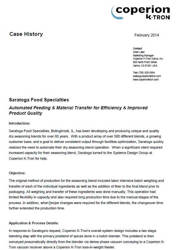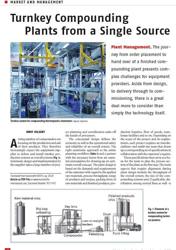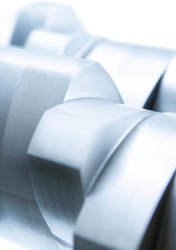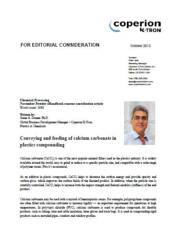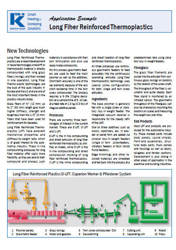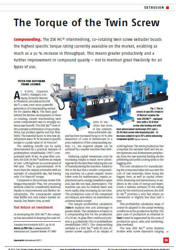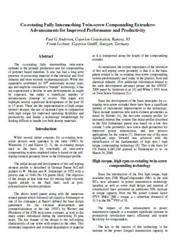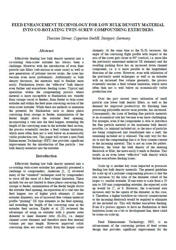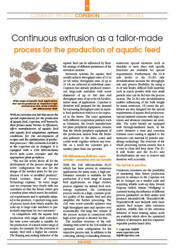Saratoga Food Specialties, Bolingbrook, IL, has been developing and producing unique and quality dry seasoning blends for over 60 years. With a product array of over 500 different blends, a growing customer base, and a goal to deliver consistent output through facilities optimization, Saratoga quickly realized the need to automate their dry seasoning blend operation. When a significant client required increased capacity for their seasoning blend, Saratoga turned to the Systems Design Group at Coperion K-Tron for help.
Publications
Showing all publications
-
Saratoga Food Specialties - Automated Feeding & Material Transfer for Efficiency & Improved Product Quality
Case Study
-
Turnkey Compounding Plants from a Single Source
Kunststoffe International, 09/2013
The journey from order placement to hand over of a finished compounding plant presents complex challenges for equipment providers. Aside from design, to delivery through to commissioning, there is a great deal more to consider than simply the technology itself.
-
Co-Rotating Fully Intermeshing Twin-Screw Compounding: Advancements for Improved Performance and Productivity
SPE, 01-2013
The co-rotating fully intermeshing twin-screw extruder is the primary production unit for compounding of polymer based materials. It also has had a long term presence in processing material in the chemical and food industry and more recently in pharmaceuticals. While this equipment celebrated its 50th anniversary several years ago and might be considered a “mature” technology, it has not experienced a decline in new developments as might be expected, but rather a significant number of advancements continue to evolve. This paper will highlight several significant developments of the past 10 to 15 years. These are the implementation of high torque (power) designs, the use of increased rpm in conjunction with high torque for improved operating flexibility and productivity, and finally a technology breakthrough for feeding difficult to handle low bulk density materials.
-
Nano Direct Process for Compounding of Nanocomposites
SPE
Numerous varieties of polymer nano-composites have been developed on the laboratory scale and characterized regarding their properties. These include, nanofiller based on exfoliated clay, nanosilver, carbon nanotubes (both single and multiple wall geometry), zinc oxide, silica, and graphene among others. Carbon nanotubes (CNT) are of particular interest as they play a pecial role when it comes to improving or creating electrical conductivity in a polymer matrix.
-
Chemical Processing
Conveying and feeding of calcium carbonate in plastics compounding
Calcium carbonate (CaCO₃) is one of the most popular mineral fillers used in the plastics industry. It is widely available around the world, easy to grind or reduce to a specific particle size, and compatible with a wide range of polymer resins. Plus it’s economical. As an additive in plastic compounds, CaCO₃ helps to decrease the surface energy and provide opacity and surface gloss, which improves the surface finish of the finished product. In addition, when the particle size is carefully controlled, CaCO₃ helps to increase both the impact strength and flexural modulus (stiffness) of the end product.
-
Long Fiber Reinforced Thermoplastics - New feeding technologies
Compounding World
Long Fiber Reinforced Thermoplastics are a recent development in newer technologies where PP or thermoplastic material is directly compounded with long glass fibers (rovings) and then molded in one operation. Long Fiber Thermo-plastic technologies are the buzz of the auto industry in Europe and the US and are one of the most important trends in the plastics industry today. Glass fibers of ½” (12 mm) up to 2“ (50 mm) length give much higher stiffness, strength and toughness than the 1/8“ (3 mm) fibers that have been used for reinforcement for decades.
-
The torque of the twin screw
Kunststoffe international
The ZSK Mc¹⁸ intermeshing, co-rotating twin screw extruder boasts the highest specific torque rating currently available on the market, enabling as much as 30 % increase in throughput. This means greater productivity and a further improvement in compound quality - not to mention great flexibility for all types of use.
-
Co-rotating Fully Intermeshing Twin-screw Compounding Extruders: Advancements for Improved Performance and Productivity
ANTEC 2011
The co-rotating fully intermeshing twin-screw extruder is the primary production unit for compounding of polymer based materials. It also has had a long term presence in processing material in the chemical and food industry and more recently in pharmaceuticals. While this equipment celebrated its 50th anniversary several years ago and might be considered a “mature” technology, it has not experienced a decline in new developments as might be expected, but rather a significant number of advancements continue to evolve. This paper will highlight several significant developments of the past 10 to 15 years.
-
Feed Enhancement Technology for low bulk density material into co-rotating twin-screw compounding extruders
SPE 2011
Effectively feeding low bulk density material into a co-rotating twin-screw extruder has always been a challenge. However with the introduction of even finer particle size fillers (sub-micron in some cases) as well as new generations of polymer reactor resins, the issue has become even more problematic. This paper will review a new Feed Enhancement Technology (FET) that provides significant improvement for the introduction of fine particle / low bulk density materials into the extruder.
-
Continuous extrusion as a tailor-made process for the production of aquatic feed
International Aquafeed Directory 2011
With an extrusion test lab that meets the special requirements for the production of aquatic feed, Coperion, well known by their former name Werner & Pfleiderer, offers manufacturers of aquatic feed and aquatic feed adaptations optimum conditions for the development of recipes and the optimization of production processes. This extrusion test lab is at the Coperion site in Stuttgart. It is equipped with a ZSK MEGAvolume PLUS twin screw extruder and the appropriate plant periphery.
